Marketing Spotlight: Procurement IQ’s approach to sales and marketing
Article summary
Share
Every procurement team today faces a constant flow of market data, supplier options, and complex decisions. For vendor analysis to contract negotiation, navigating all this information can quickly become overwhelming, and costly if mismanaged. So why piece together fragmented reports and outdated insights when you could access a smarter, centralized source designed to make procurement efficient and informed?
At Milk and Cookies Studio, simplicity and strategy go hand in hand, without wasting time and resources.
In today’s Marketing Spotlight we have ProcurementIQ, a provider of market intelligence and procurement research with a focus on delivering data-driven insights to help teams make intelligent purchasing decisions. As a division of IBISWorld, they bring decades of industry expertise to equip buyers with up-to-date analysis and actionable strategies.
What makes ProcurementIQ stand out in the vast landscape of research providers? Beyond offering thorough reports and supplier profiles, their marketing approach is a balance between expert content, practical tools, and targeted outreach.
Ready to see how ProcurementIQ combines deep expertise with focused marketing to win over procurement professionals? Let’s explore their brand, positioning and demand generation strategies and marketing approach.
📝 A quick note before you start reading:
The data and analysis in this article are valid as of the time we wrote it. We don’t know when you’ll be reading this, maybe next week, maybe six months from now, and things might have changed since we looked at this company’s marketing and sales approach. Still, the insights and lessons here stay useful, even if the numbers or tactics have evolved a bit.
Understanding ProcurementIQ
Procurement IQ is a provider of procurement research and market intelligence for public, private procurement and academic institutions. As they say, their “comprehensive suite of products and services can help your procurement department”.
The company was founded in 2013 and has offices in Los Angeles, New York, Melbourne, London, Frankfurt and Beijing. The company is a division of IBISWorld Inc, a global industry and market research firm founded in 1971.
They offer reports and analysis on a wide array of products and services, helping procurement professionals make informed purchasing decisions, reduce costs, and mitigate risks associated with supplier selection and contract management.
Now that we have an idea about what they do, let’s go into more details.
On LinkedIn they have around 2K followers, and 53 associated members. The median tenure of 5.7 years suggests that the company has a relatively experienced workforce. Most of their employees are involved in sales and business development.

Brand Promise Analysis
Their brand promise is clear and upfront on the main page: “intelligent purchases, driven by data.”

This talks about the potential of their data-driven insights, which is intelligent purchase.
Using the term “intelligent” means a more proactive data-driven, and strategic approach to data using to anticipate needs and optimize purchasing choices.
Positioning procurement as “intelligent” improves the brand’s value, makes it more appealing to decision-makers who seek efficiency, accuracy, and **foresight (**the ability to anticipate future needs and challenges) in purchasing.
By explaining the term intelligent purchases means that they offer market intelligence reports that cover a full spectrum of insights: from vendor analysis and pricing trends, to key negotiation levers. The result? Clients have the knowledge they need to make informed decisions in every part of the procurement process.
Service and Product Breakdown

From the Products tab we learn that they have 4 categories of products: Market Intelligence Categories, Supplier Profiles, Custom Research and RPF Templates.
1. Market Intelligence categories, provided in the U.S., Canada and Europe.
They offer solutions for 16 verticals. Prospects can select a specific vertical (e.g.: technology, healthcare) and country to narrow down their search.

For each vertical, there’s a range of detailed reports across various sectors. For instance, if we look at Engineering, Research & Technical Services, there are 43 reports covering different aspects.
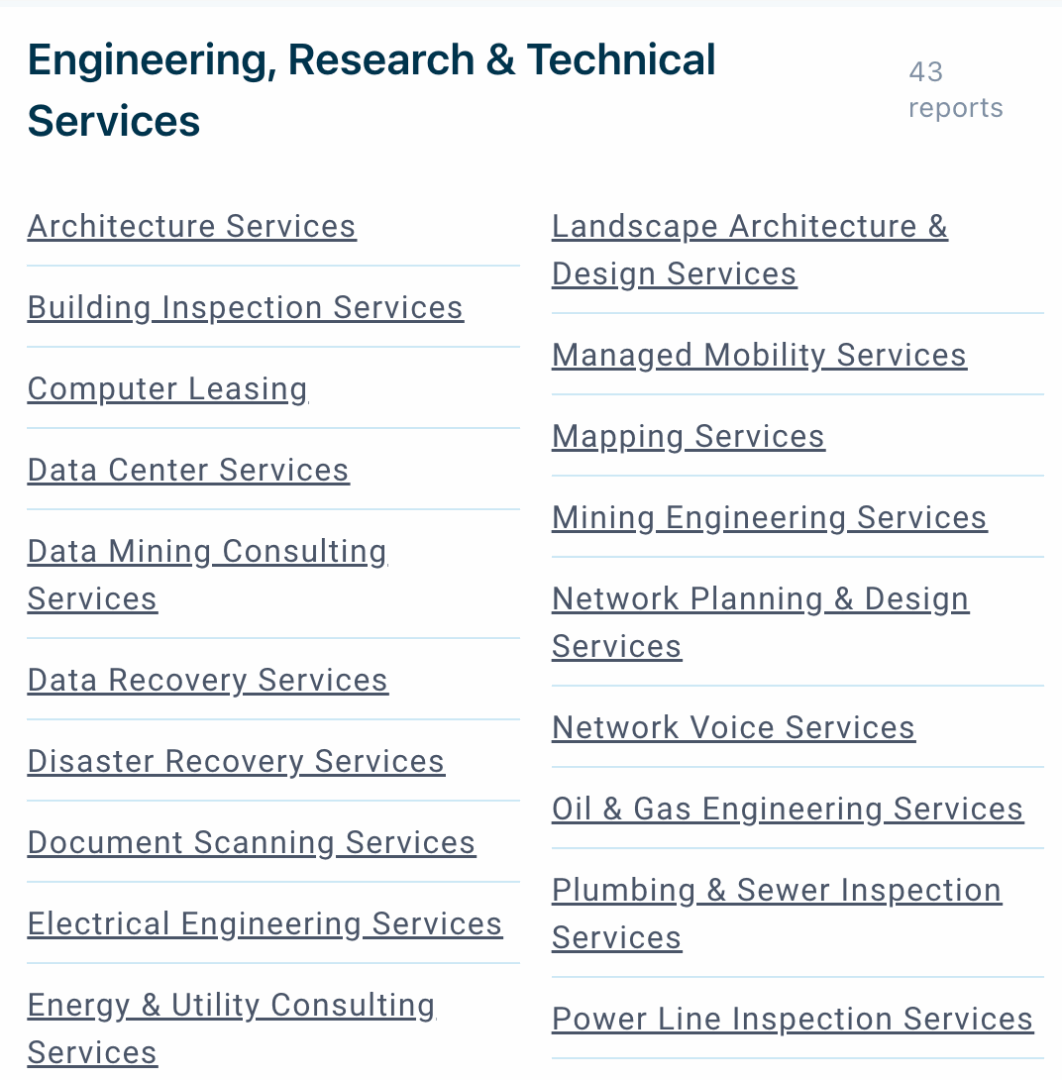
Each report page provides a clear breakdown of: what’s included and excluded in the report, key global trends affecting specific procurement services and a map that shows suppliers by region, for added visualization.

They also have a quick navigation menu to help users explore more easily, divided in Overview and Geography Drilldown.

At the bottom of each page, they include a strategic call-to-action (CTA) inviting users to start a 7-day free trial or book a demo to learn more about ProcurementIQ’s offerings. The page is filled with additional CTAs, like “Book Demo”, “Learn More”, and “View Sample”, guiding users to take the next step.

2. Suppliers profiles
This category provides financial data, competitor rankings, SWOT analysis and other critical information in one location.

They provide a free sample report, ending with their sales pitch.

They also use interactive charts and graphs that makes the information more engaging and easier to understand.
The page starts with a bold statement: “All of Your Supplier Intelligence in One Place”, highlighting the core value of their offering, explaining what pain points they touch.
They’re saving users time and effort. Instead of searching across multiple sources, users can find all the supplier information they need on a single platform.
3. Custom research

As seen on other pages, they offer a project sample. They use the same type of statements regarding what needs are they solving. This helps businesses with challenging research tasks that require specialized knowledge and resources.
4. RPF Templates:

With this product, they show the ability to create RFPs fast, showing the efficiency benefits, standardised templates that improves consistency and visibility, and usage templates that lead to better RFPs and more robust responses from suppliers.
Also, the page includes multiple CTAs, such as “View Sample Template,” “Book Demo,” and “Try Us For Free 7 Days.”
Differentiators and Unique Assets
For starter, you can go their section on the About Us page, where they try to answer this question.

Here is their Unique Selling Proposition (USP)
- Tailored to unique needs: “ProcurementIQ caters directly to procurement professionals”
- Easy access to insights: “Our research follows a consistent table of contents, meaning you can easily find what you need.”
- They offers actionable insights: “We address seven common steps in the procurement process, with actionable insights to guide you.”
- **Personal advisor: **“And, as a member, you have a dedicated account manager to leverage for project-specific advice, training, and improving end user understanding and use of the reports.”
They reinforce the idea of trustworthiness with statements like: “work smarter and more efficiently with trustworthy market intelligence.” and backing this up by showing that major companies like Ally, Amtrak, EY and Kohler already rely on them, building even more credibility.

Conclusions
ProcurementIQ shows that they understand the complexities and challenges that procurement professionals face like: time wasted researching unfamiliar categories, frustration by generic or outdated market data and the lack of support for internal and external negotiations.

To fight these challenges, they offer solutions like custom research and templates with a dedicated account manager, circling back to their brand promise to help companies “Work smarter and more efficiently”.
Social Media Strategy
We want to understand more about their marketing strategy so we will analyze ProcurementIQ’s social media presence, as of November 2024.
We’ll be looking at their LinkedIn, Facebook, and any other channels they use, including their leadership social media presence. Some will heavly take advantage of the power of social media and others don’t. What we want to see is how the chosen strategy works for ProcurementIQ.
Leadership Presence Analysis
We usually check the LinkedIn profiles of CEO and CMO of the companies that we are analyzing. For ProcurementIQ we couldn’t do that, as we can’t find their profiles.
As mentioned before, ProcurementIQ is a division of IBISWorlds’s, so we went to check their CEO profile. Karen Dobie has a modest LinkedIn presence and activity, with last activity from one month ago. We also checked the profile of Head of Content, Naren Sivasailam, but again, no recent activity that could give us more information to analyze.
Let’s continue with the company’s presence on Social Media.
Company

ProcurementIQ’s LinkedIn page have 2,107 followers using this statement “A market intelligence partner providing a range of products that meets procurement’s specific needs.” as their profile’s description.
By using this concise and direct messaging, everyone can understand what ProcurementIQ offers. They establish themselves as being a market intelligence partner. The use of the word partner emphasizes collaboration and positions them as an ally to procurement professionals rather than just a service provider.
By highlighting that they provide products that meet procurement’s specific needs, they reinforce their commitment to tailored solutions, addressing the unique challenges faced by their clients.
In the HOME section, we see that they share a 6 years old link to YouTube. This could mean that the company might not be regularly updating their LinkedIn content.
How often do they post?
Compared to the other companies we have analysed, Procurement IQ does not post as often. It seems that they post a couple times a week, in the best case.
In the last 3 months they have had a total of 12 posts. It’s clear that LinkedIn it’s not their primary channel to promote themselves. This could happen if their ideal customer profile is not active on this platform. Therefore, why would you spend the time to customize and be active, where “no one” could hear you?
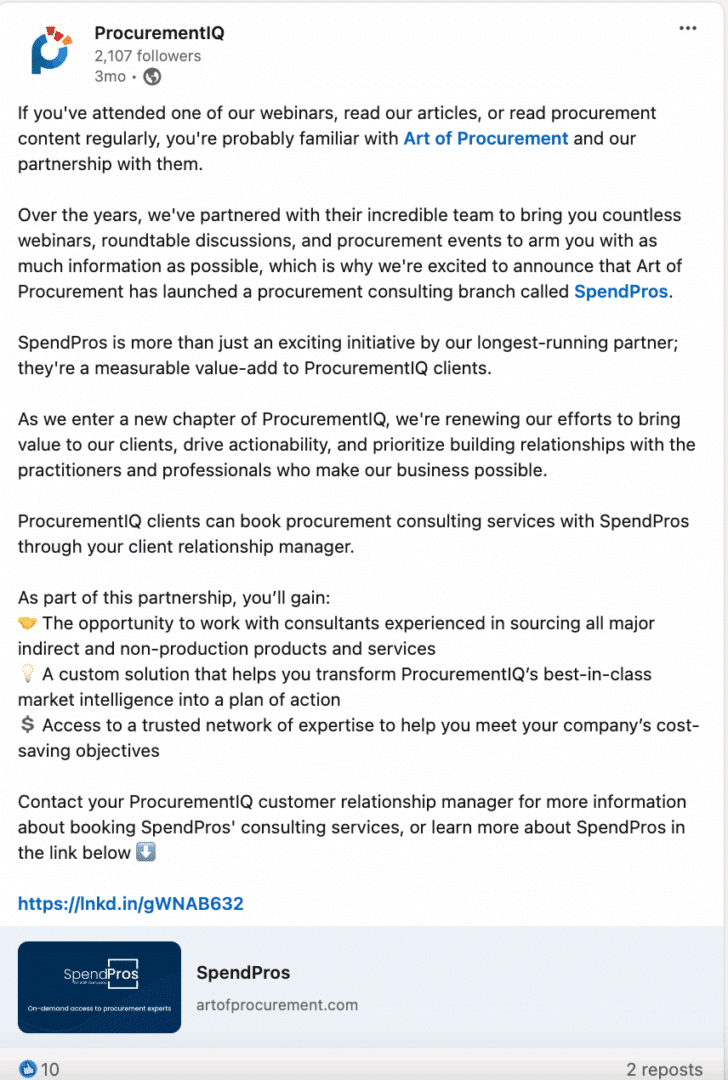
They have a modest engagement rate, with few likes and fewer comments. By choosing not to engage on this channel and post regularly, they couldn’t have big numbers attached to their posts.
Content Pillars
ProcureTech Demos:
They regularly repost demos of various ProcureTech solutions through live videos, either held by them or by other peers.
In the example below, ProcurementIQ is referencing a recent demo of Sievo, a software platform that helps streamline procurement workflows. The post highlights the challenge of organizing large amounts of data and how Sievo can help automate this process. At the end, they praise Sievo for its ability to simplify procurement processes and being in alignment with ProcurementIQ’s core values.
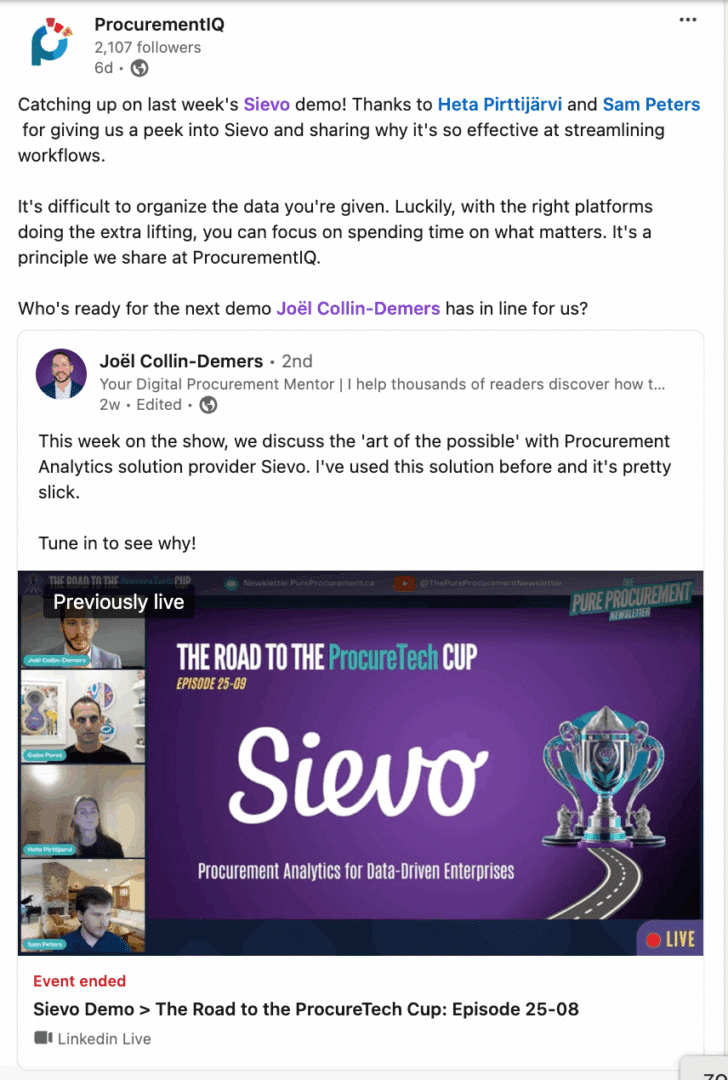
Educational content:

They often chose to promote their blog page, like in this example. The post kicks off with a statistic that highlights a problem procurement professionals might face, instantly capturing attention.
Mentioning “dark patterns” adds intrigue, hinting at potentially unethical business practices to watch out for. By featuring their Lead Analyst, Lucas Hahn, ProcurementIQ positions itself as a trusted source of knowledge and expertise in the field.
They also provide a clear solution, the blog post, which promises to help readers steer clear of these “dark patterns.”
The call to action, “Stay ahead of these cost trends”, reinforces the value of reading the blog, highlighting the benefits for anyone wanting to stay informed and proactive.
ProcurementIQ’s culture and environment:
The company promotes a strong team culture by resharing posts from employees and congratulating them on their anniversaries.
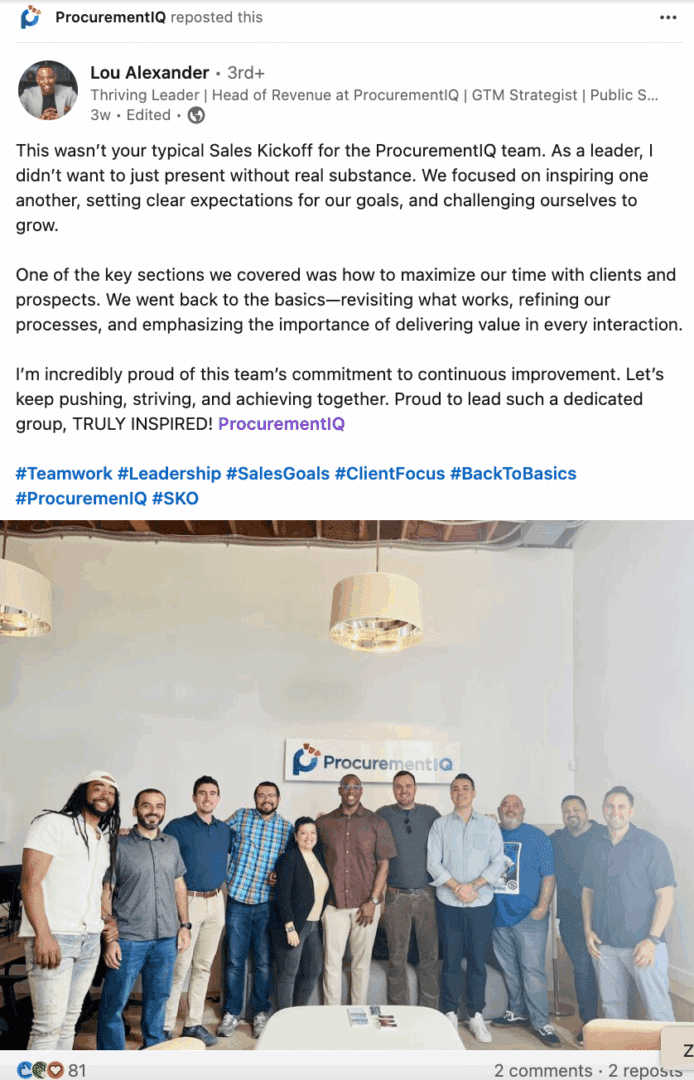

Informative Content:
Within this pillar, although it’s not their main one, they provide valuable and recent and up-to-date information about a current event that is relevant to their specific audience.

They don’t have a LinkedIn newsletter, so the only way to bring leads to their website is by sharing blog posts. By spending so little resources and time on LinkedIn, they show us that this is not their focus.
We have noticed that Procurement IQ’s other social media profiles: Facebook, X (ex-Twitter) and Instagram are inactive since 2019-2021.
Conclusions
As we saw, ProcurementIQ’s social media presence is low, with their only active account beign the LinkedIn page. By not promoting this page more, it seems that being viral is not a priority at the moment.
They focus more on face-to-face interactions by participating at industry events, where their prospects may be.
A survey conducted by the Content Marketing Institute found that B2B marketers consistently cite LinkedIn as the social media platform that delivers the best value for their organization. Therefore, companies wanting to promote themselves and generate leads should use LinkedIn more effectively. For example, companies can share valuable content, such as white papers, articles, and case studies on LinkedIn, which can help with their visibility and position them as thought leaders in their industry.
ProcurementIQ is constantly using statistics to build credibility. This is a very good way to support your claims, and arguments. Overall they make your content more credible, persuasive and trustworthy.
In your content, you can use data from reputable and up-to-date sources (well-established research companies, or companies like McKinsey) to support your points. You could also improve engagement by presenting statistics through graphs, charts, or infographics.
An optimized LinkedIn ‘About’ page can do only good for your company. You can emphasize the value propositions and the specific benefits your SaaS offers. Explaining how your services lead to outcomes such as cost savings, risk mitigation, or data-driven decision-making are important pain points for companies, but of course, try to adapt to your ICP pain points.
Sharing valuable industry content that educates your audience, whether it’s a thought leadership piece or a unique point of view is important. If you’re a SaaS company in a similar industry, leverage the insights from your reports to create additional content. For example, you could offer valuable insights focused on specific regions or verticals. If you can, try to incorporate visualization in your content, to improve engagement and make the info easier to grasp.
Demand Generation Strategy
In this part, we’re taking a look at ProcurementIQ’s demand generation strategies, with a focus on content marketing, as of November 2024. We’ll cover areas like blog, community building, resource centers, newsletters, and more.
ProcurementIQ’s blog and articles
The Articles section on their website is well defined. Right from the start, visitors see a short description outlining the themes they’ll find like cost avoidance, stakeholder management, vendor selection, and news and trends that impact the market.

The topics covered are relevant to procurement professionals, as they address common pain points such as the need to lower the cost or selecting a reliable vendor.
Their content is focused on:
- Supply Chain Disruptions
- Supply chain trends
- Economic Trends
- Cost avoidance
- Technology
- Strategic sourcing
- Category Management
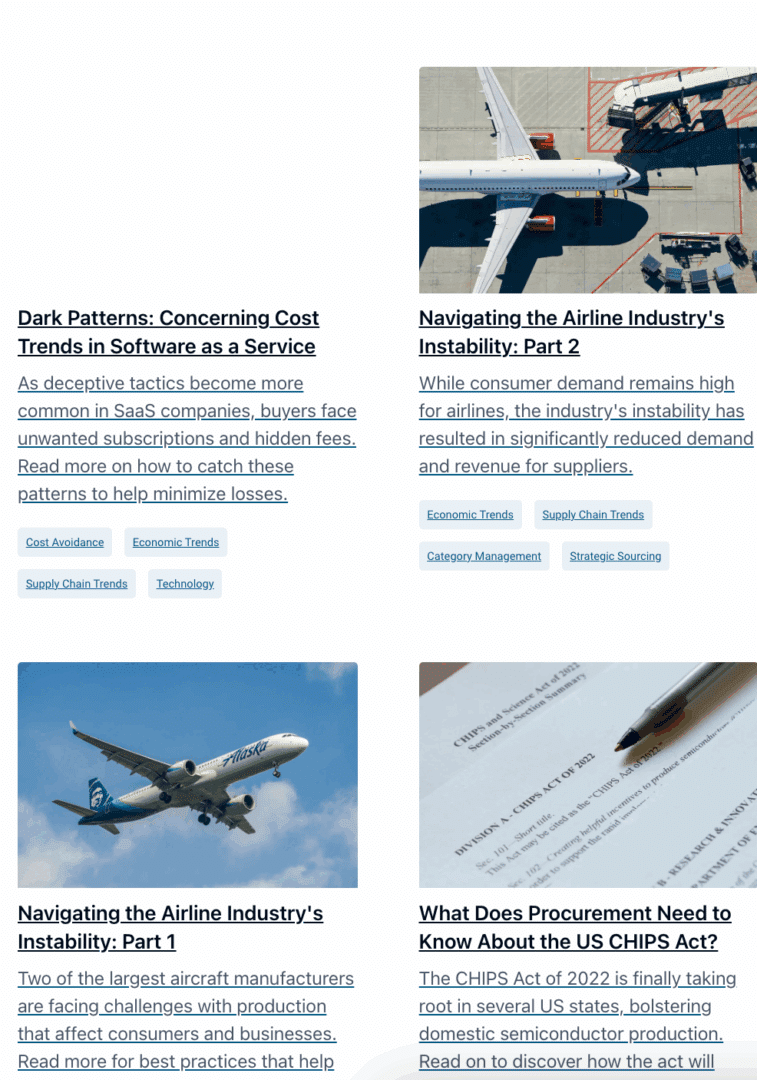
The length of most blog posts is big, with articles around 2,000 words. This longer format is ideal for SEO, from the use of more keywords, especially for complex topics like procurement. The tone of voice used in the blog posts is professional and informative. They don’t have a tight schedule regarding the blog. There are months with zero posts, and some with a couple of articles.
Their blog posts include statistics that support claims and arguments. This shows a commitment to factual accuracy and thorough research. They put a lot of effort into their articles to present in-depth details and make them as valuable as possible, showing that they are not superficial.

Articles on subjects like the US CHIPS Act and shipping disruptions discuss the current issues procurement teams face, positioning themselves as a thought leader in the procurement industry.

Interestingly, ProcurementIQ doesn’t use direct CTAs at the end of their blog posts, opting instead to invite readers to follow them on LinkedIn or subscribe to their newsletter.
There are no social media buttons linked to the articles. This might make it a bit harder for potential leads to connect with them, because they would have to search them manually.

ProcurementIQ’s case studies
Their case studies are well structured and organized. Even though the latest ones aren’t entirely up-to-date, they offer insights into how ProcurementIQ has helped clients overcome specific challenges. Each case study walks you through the procurement challenge, how their solutions served the research process and negotiating supplier contracts. The case studies conclude with the outcomes and some of them with CTAs like “Talk to us”.

Many case studies discuss cost savings, whether through identifying cost-effective suppliers or negotiating better deals. They use the tag of “cost avoidance” for this case studies.
Real-world examples from reputable and big clients will increase their company’s credibility and trustworthiness.

Webinars
Their webinars seem to address hot topics and trends in the world of procurement. They promise that this insider advice will help you excel. The statement tells us that these sessions will keep professionals informed about the latest developments and challenges in the procurement field.

They want to position their webinars as a resource dedicated to improve decision-making, optimize supplier relationships, and help procurement professionals excel in their roles within their organizations. They’ve only hosted webinars in 2024, with the latest one on March 27.
Each webinar has a copy, starting with an introduction about the pain points in procurement. The copy is easy to understand and avoids technical jargon. They also present the webinar speakers, which adds a personal touch, especially when the technical language can make everything look stiff.
Newsletter
As we have seen, the newsletter is promoted on the blog and webinar sections. Compared to the registration for the webinars, we see that subscribing to the newsletter requires to input the business email.
Requiring only a business email for newsletter subscriptions, especially when strategically placed in high-traffic sections like blogs and webinars, is an effective tactic for expanding the company’s reach and nurturing potential leads.
These subscribers receive regular, valuable content, and they begin to build a relationship with the company. Over time, this consistent engagement fosters trust and demonstrates the company’s expertise and value.
As the connection strengthens, some of these newsletter subscribers become more interested and invested. They might decide to sign up for a webinar, request more information, or reach out for a consultation.
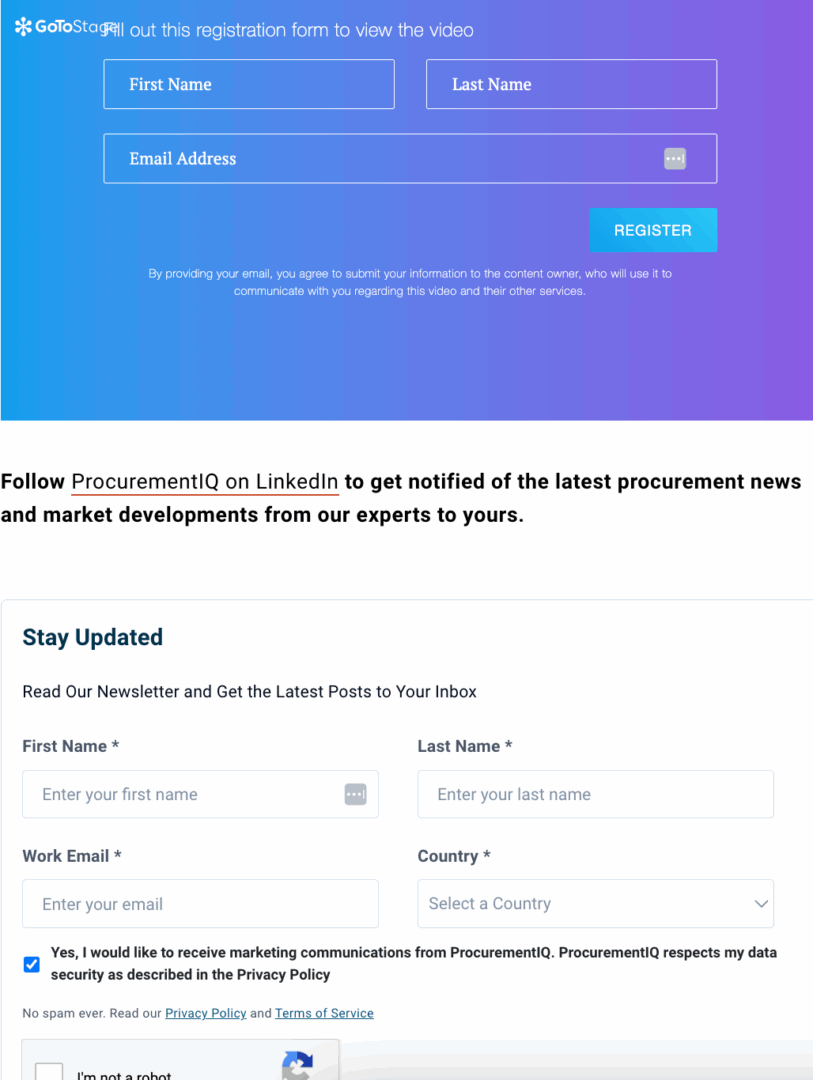
White Papers
White papers are effective tools for both demand and lead generation. They attract prospects who are looking for detailed information on specific topics, which can ultimately lead to conversions.

By producing comprehensive white papers that address real-world challenges in procurement, the company positions itself as a thought leader in the industry. This helps build trust with potential clients who are looking for credible sources of information.
This is not their main content focus, considering the fact that they posted only 4 white papers to this date, all from 2017-2018. By making generic procurement white papers and not posting regularly, they miss on opportunities like creating industry-specific versions that directly address the pain points of their prospects. For example, a white paper about supply chain disruptions could have different versions for retail versus technology companies, making the content much more relevant and actionable for each sector.
Conclusions
After exploring ProcurementIQ’s content marketing strategy (blog, articles, case studies, webinars, newsletter, and white papers) we can draw some final conclusions. Even though their posting frequency is inconsistent, they compensate by focusing on the quality and relevance of the content they do publish.
Since they’re already creating high-quality, data-driven content, implementing ABM wouldn’t require a complete overhaul of their strategy. It would simply mean being more intentional about who they’re creating content for and adding those personal touches that make target accounts feel understood in their challenges.
If some months go by without any new articles, that could lead to missed opportunities to engage with their audience. Regularly updating the blog would make prospects come back but also reinforce their role as a consistent source of industry insights. More than that, content marketing increases lead generation according to 74% of companies.
It’s a good practice to include CTA in your case studies or sales pitch. This is basically an invitation for the prospects to buy or try your product and services. It’s a natural transition after showing how your solutions benefited a client. You could use this opportunity to emphasize that you’re ready to address and solve similar challenges, regardless of the specific situation and reinforce your value proposition, reminding readers why they should consider your offering.
Including statistics allows marketers to base their strategies on evidence rather than intuition. It is important to only include statistics that directly support your message or argument. If you can find, try to reference data specific to your target accounts’ market segment. But don’t overdo it. Overloading content with numbers can overwhelm readers and distract from your main points.
It’s also a good idea to personalize your content to address the procurement challenges of different industries**.** For example, if your SaaS has a research department, then you could create content based on your research. Find what are the unique procurement challenges of different industries or organization types, add your point of view and how your services can address these challenges.
Post case studies, blog posts and other valuable resources regularly to show your company’s continuous ability to deliver results and to increase site traffic. Regularly sharing case studies allows potential customers to see real-world examples of how others have benefited from your services, in a certain economic time. Maybe there were some events in 2024 that affected the procurement industry and your case study will show what were the challenges of other companies and how your solutions successfully help them.
You could also create a description for your newsletter and give a reason why they should subscribe. Otherwise, after some time, you email could end up being just another spammy email. So, a well-crafted description helps subscribers understand what to expect from the newsletter and the value it brings. This can also help build trust and encourage subscriptions.
Also, when subscribers know what they will gain from the newsletter, they are more likely to look forward to receiving it. This anticipation can lead to higher open rates and engagement levels, as subscribers become more invested in the content provided and possibily turning them into clients over time.
SaaS companies could consider implementing an ABM approach to target their highest-value, most strategic accounts. This may include large enterprises, government agencies, or other organizations with significant procurement needs. After identifying the strategic accounts, ABM can be combined with content marketing.
Lead Generation Strategies
Landing pages
Landing pages are designed to collect visitor information, such as names and email addresses. They typically have a clear call-to-action (CTA) and persuasive copy to encourage sign-ups or other actions.
1. Talk to us about a free 7-days trial
This page is designed to capture the basic contact details of their leads. This comes with an opt-out checkbox for newsletter subscribing. Pre-ticking a checkbox can significantly boost the number of people who subscribe to a newsletter or mailing list. It’s a subtle psychological trick that leverages the default option bias. People are more likely to leave a box checked than to uncheck it.
Note: While this tactic can be effective, it’s important to be transparent and ethical. Some users may feel annoyed or deceived if they accidentally sign up for a newsletter they didn’t intend to.
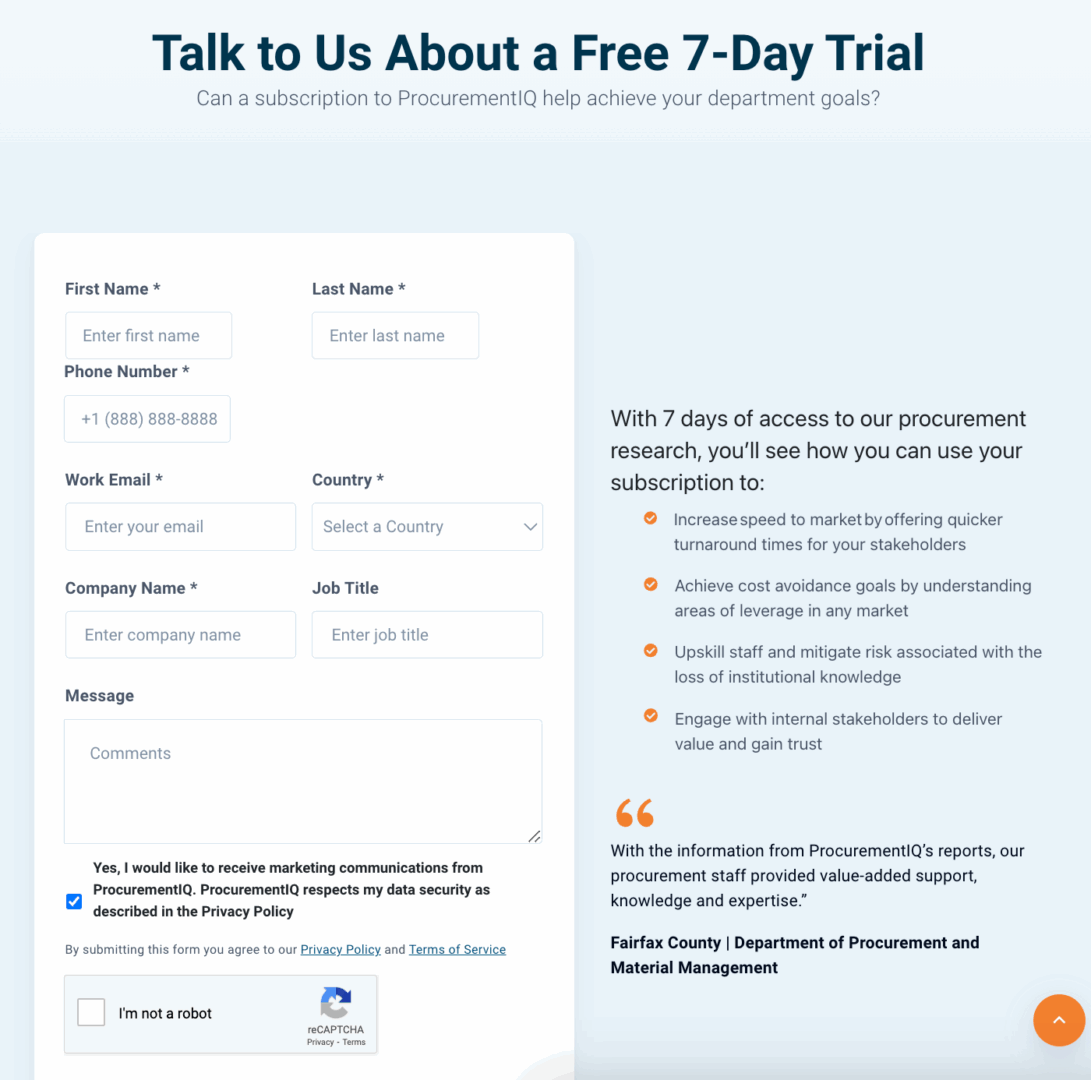
Usually, the free trials are, well…free. ProcurementIQ makes you contact them, rather than simply allowing users to sign up for a free trial. This strategy encourages potential customers to engage in a direct conversation with them, which can help build credibility and trust. In these discussions, prospects can talk about their pain points and ask for a solution.
In another way, this strategy can have a downside, and that is to scare away some leads that prefer quick access without additional steps.
2. Download a Free Market Intelligence Report
This landing page follows the same strategy as the 7-day Free trial one.
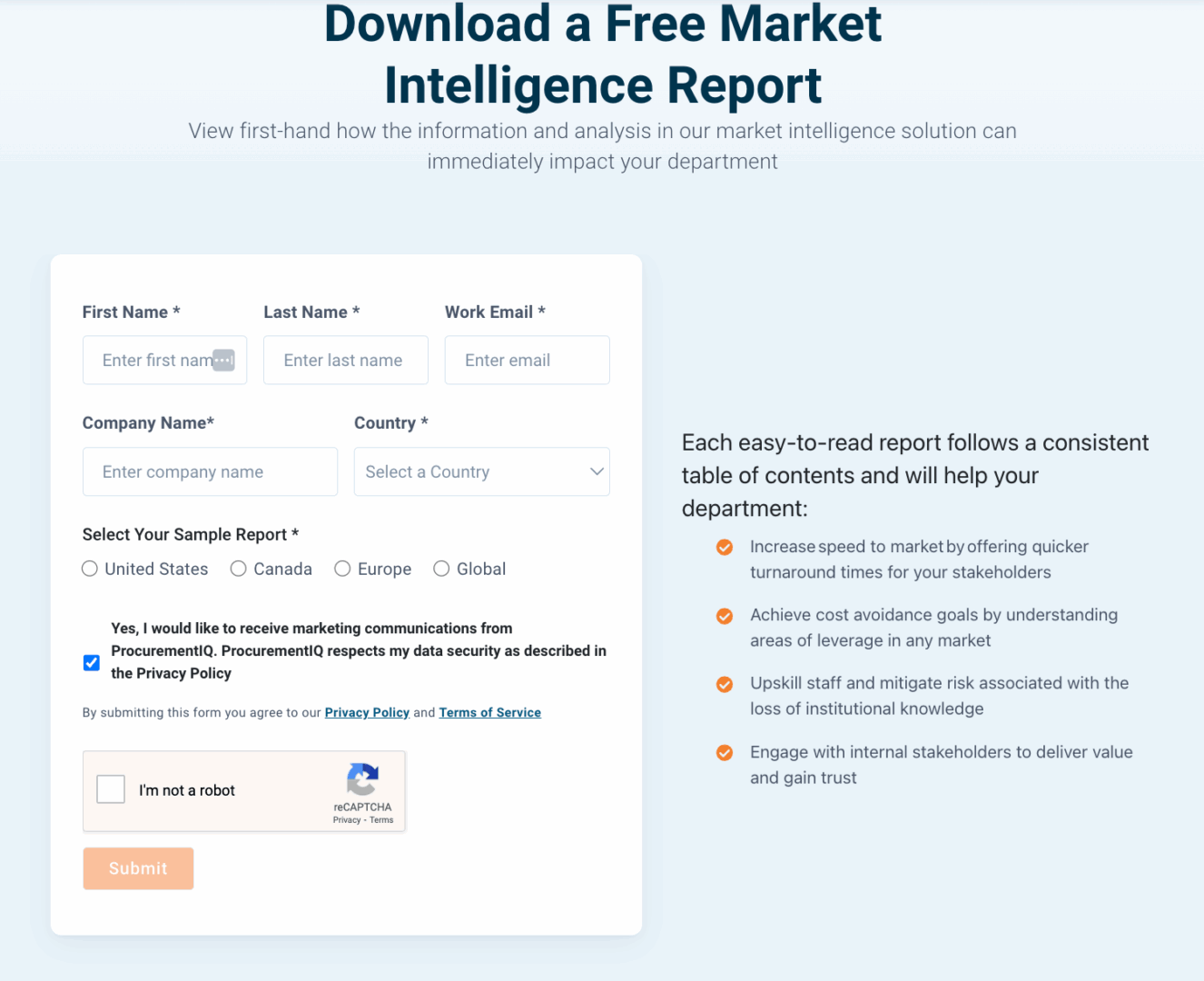
In addition, here they require you to select your sample report specific to a location. This field helps gauge what specific areas of interest potential customers have regarding ProcurementIQ’s offering. This segment leads based on geographic location and helps them tailor their services and marketing strategies to different regions.
3. Robust Procurement Research for European Markets
The primary goal of this landing page is to promote ProcurementIQ’s European Market Intelligence Report. By inviting visitors to provide their contact information in exchange for access to reports or trials, ProcurementIQ can build its customer database and nurture potential clients.

Downloadables
ProcurementIQ offers downloadable content, without any preview of the content. These sample content can be downloaded through the orange button.


The Your Source for Lightning-Fast RPFs sample template they gave us a Word document. This template is from 2022, which can seem to be outdated and does not contain any CTA that could redirect the lead to a contact form.
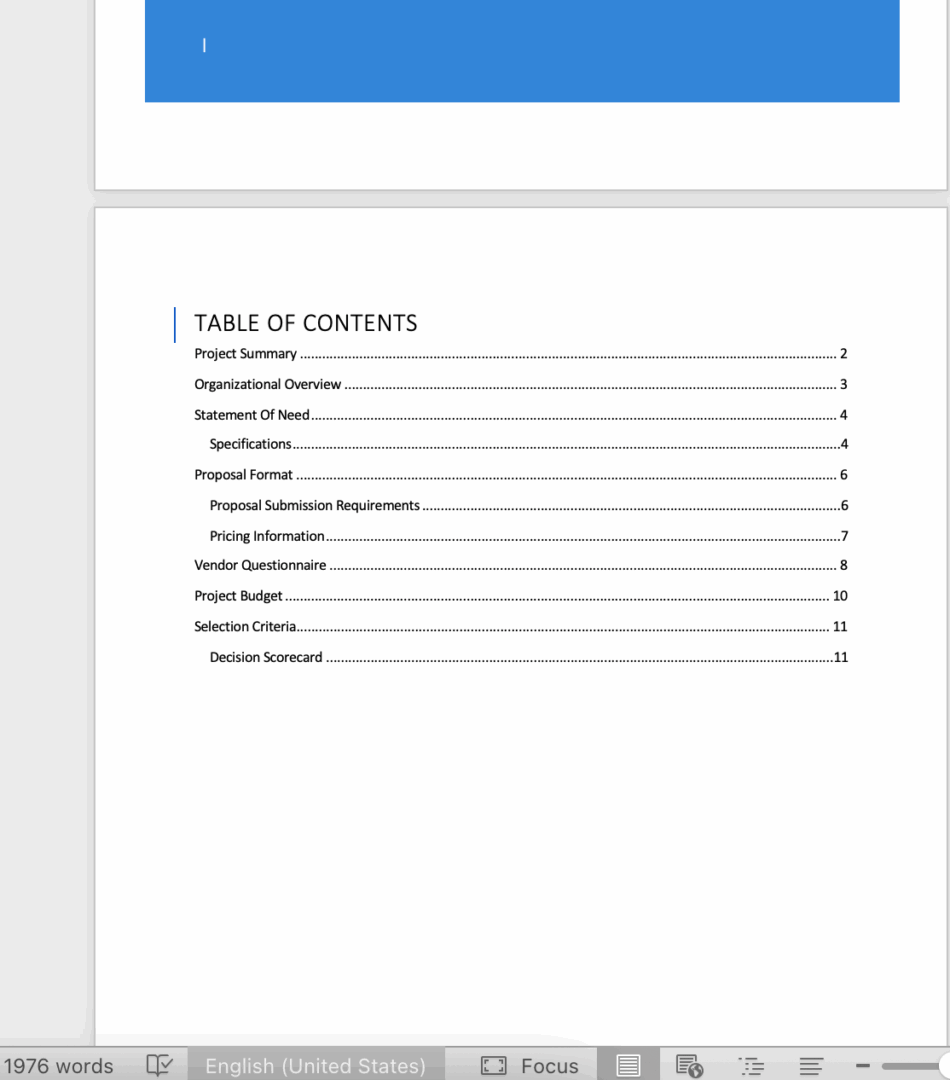
Paid Advertising Strategy
ProcurementIQ has in total 17 ads on LinkedIn.
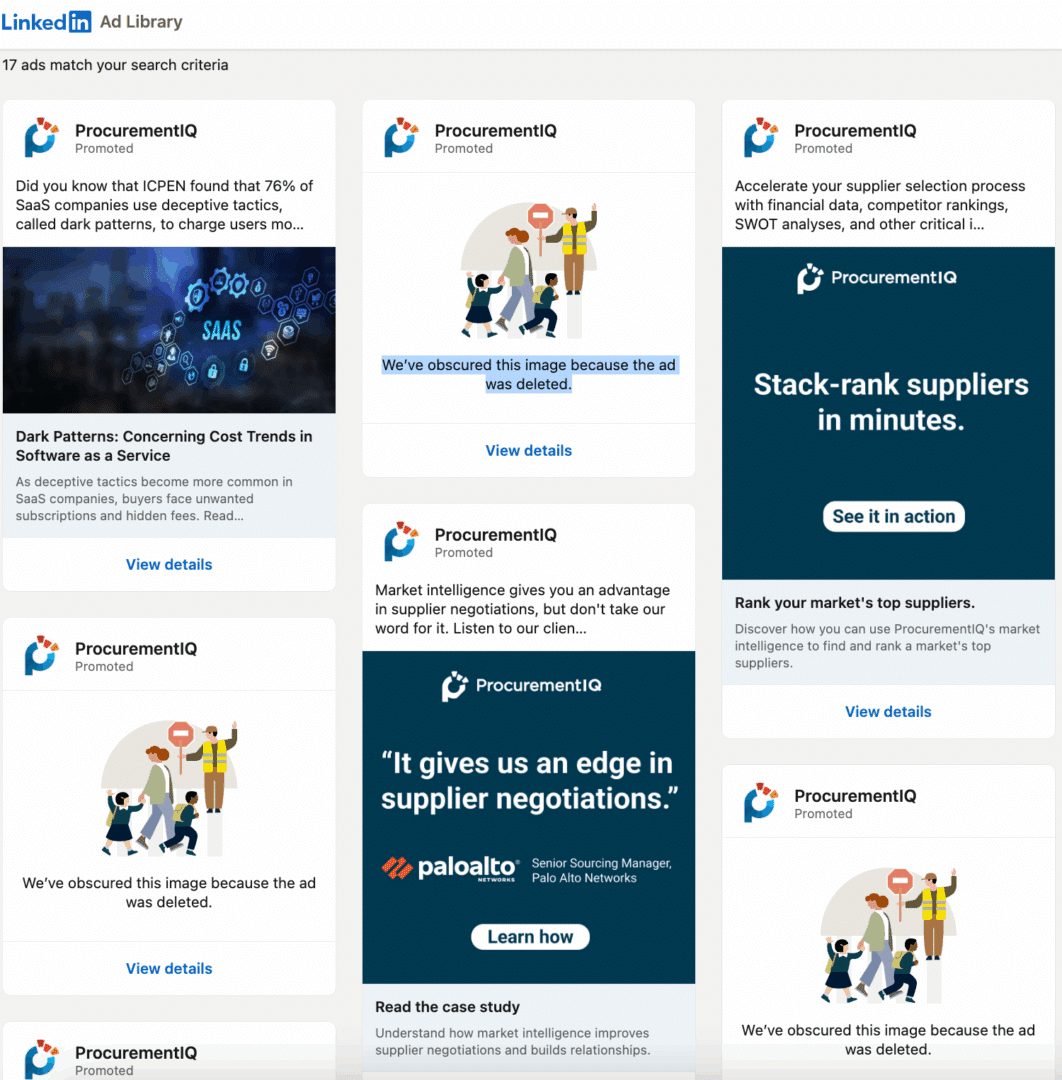
They probably were more, but they were deleted, due to either policy violations, user-initiated removal or expired campaigns.
They use paid ads to promote their blog articles, case studies, and some videos from their Youtube channel (unlisted for the general public).
Regarding paid advertising, analyze which content assets and campaign messaging resonate best with your ICP. Track performance metrics and continuously optimize your ad and targeting to improve ROI. Also, be mindful of any policy violations or user feedback that may lead to ad removals, and make adjustments accordingly.
Given ProcurementIQ’s extensive industry expertise and ability to produce high-quality content, they could consider expanding their library of lead magnets. For example, our clients reported seeing higher conversion rates when using lead magnets. Prospects are often willing to provide their email addresses and other information in exchange for access to premium, informative content that addresses their pain points.
An outdated resource can give the impression that your organization is not keeping pace with industry changes, so regularly review and refresh this type of content. Additionally, consider gating some of your most valuable resources behind lead capture forms to generate more qualified leads.
Consider using a similar approach of providing a clear value proposition and call-to-action. You could also experiment with different lead magnet offers, like free trials or downloadable content in exchange of contact details.
Conclusions
Their lead generation strategy is traditional and very simple. ProcurementIQ uses landing pages with pre-ticked newsletter subscription checkboxes and clear calls-to-action to capture leads. The leads are then nurtured through the newsletter and hopefully, converted into paying customers.
Also, displaying a “Free Trial” button prominently on the website is a common lead generation strategy, as the button catches visitors’ attention and encourages them to try ProcurementIQ’s products.
Overall, ProcurementIQ’s focus on lead generation through landing pages downloadable content, and CTAs to attract potential clients.
Inspiration points
- FAQ section: ProcurementIQ’s FAQ section is well structured. The FAQ is divided into separate sections (General, Pricing, Custom Research, Supplier Profiles, RFP Templates), making it easy for users to find relevant information quickly. They also address the pricing issue, advising their prospects on the benefits of subscribing to their services, rather than just purchasing individual reports, because, as they say, it may be more cost effective to explore an annual membership with ProcurementIQ.
- Using statistics in their content: ProcurementIQ uses statistics in their blog articles and this lends credibility to the content, as it is backed by data rather than just opinions.
- Project samples: ProcurementIQ makes it easy for visitors to browse past projects across areas like vendor sourcing and cost structure analysis. This transparency gives potential customers a clear idea of the deliverables they can expect. Providing visible project samples allows prospects to evaluate ProcurementIQ’s capabilities and the quality of their work.
- Your business type: ProcurementIQ has a dedicated page for defining their their Ideal Customer Profile (ICP) while also outlining the purpose and benefits of their offerings. This section helps potential customers quickly determine if ProcurementIQ’s offerings align with their needs.
If your SaaS company needs expert help in creating effective marketing and sales strategies, Milk and Cookies Studio would be happy to assist you.
We specialize in helping businesses like yours develop lead generation strategies, create content that converts, and build strong customer relationships. Let’s discuss how we can support your growth.
Frequently Asked Questions
1. What is ProcurementIQ and what does it offer?
ProcurementIQ is a division of IBISWorld that provides procurement research and market intelligence to procurement professionals across industries. Their offerings include market intelligence reports, supplier profiles, custom research, and RFP templates, helping buyers make informed decisions, reduce costs, and mitigate risks.
2. What makes ProcurementIQ different from other procurement intelligence providers?
ProcurementIQ stands out by offering actionable insights tailored to procurement professionals, easy-to-navigate research formats, dedicated account managers, and a wide range of tools that support every step of the procurement process, from vendor analysis to negotiation support. Their credibility is also reinforced by partnerships with well-known companies like EY, Amtrak, and Kohler.
3. How does ProcurementIQ approach content marketing?
ProcurementIQ focuses on long-form, high-quality content including blog articles, case studies, webinars, and newsletters. Their blog covers topics like cost avoidance, strategic sourcing, and supply chain trends. While their posting frequency is inconsistent, their content is data-driven and addresses key procurement challenges.
4. What lead generation tactics does ProcurementIQ use?
ProcurementIQ uses simple, traditional lead generation tactics such as landing pages offering free trial requests, sample reports, and downloadable templates. Many of these pages include pre-ticked newsletter checkboxes and segmented forms to collect relevant lead information. These leads are then nurtured through newsletters and email outreach.
5. Is ProcurementIQ active on social media?
ProcurementIQ’s social media presence is limited, with only their LinkedIn page being moderately active. They post infrequently and focus mainly on resharing demos, blog articles, and employee highlights. Other platforms like Facebook, Instagram, and X (formerly Twitter) have been inactive since 2019–2021.


